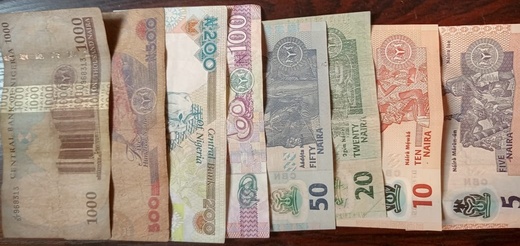The naira is a legal tender of Nigeria. It uses ₦ (sign) and NGN (code). The Nigerian currency is in coins and banknotes. But the coins have died a natural death due to high inflation making them lose their total value and relevance in the economy.
- Issuer: Central Bank of Nigeria
- Website: cbn.gov.ng
- Printer: Nigerian Security Printing and Minting Company Limited (CBN is the largest shareholder)
- Website: mintnigeria.com
Naira Design
On November 23, 2022, NGN200, NGN500, and NGN1,000 get a new design, which was launched in Abuja by President Muhammadu Buhari.
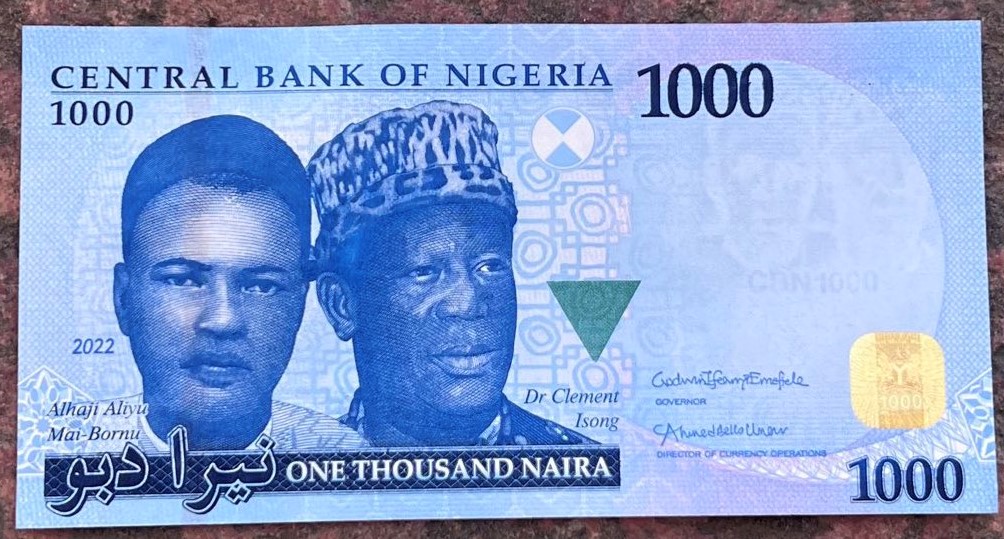
According to CBN Governor, Godwin Emefiele, the action was to take full control of the currency in circulation and eliminate counterfeiting banknotes in circulation among other reasons for redesigning the currency.
The issuer of Nigerian Currency
The Central Bank of Nigeria (CBN) is the sole issuer of the naira. The apex bank does not only issues the naira, it also performs other monetary roles in Nigeria’s economy.
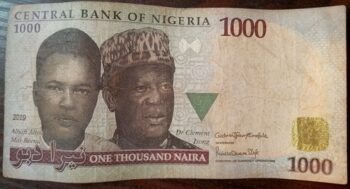
Some other roles of the CBN in terms of naira include:
- Controls the volume of naira in circulation
- Gives exact figure of naira in circulation
- It ensures price and monetary stability.
- Through its Currency Operations Department, the CBN also reissue currency
- Disposal of bad banknotes
- Withdrawal of old notes from circulation
- Providing enlightenment how to recognise fake notes among other functions
Birth of Naira
The name “naira” was coined from the word “Nigeria” by Chief Obafemi Awolowo, the first Premier of the Westen region who later became the Federal Commissioner of Finance.
Till December 31, 1972, the official currency in Nigeria was the Nigerian pound. “Pound” because Nigeria was the British colonial administration.

So, when the first naira was introduced on January 1, 1973, it replaced the Nigerian pound at a rate of 2 naira to 1 pound.
The military regime of Gen Yakubu Gowon who was the leader of Nigeria at the time launched the new Nigerian currency amid funfair.
All the circulating coins of the Nigerian pound were withdrawn from circulation and replaced with the coins of the new currency.
It made Nigeria, the last former British colony abandon the £sd currency system in favour of the decimal currency system. The country gained independence on October 1, 1960.
Using the naira to control inflation
Since the introduction of the first Nigerian currency, it has undergone several readjustments, redesign, introduction and withdrawal of new banknotes and coins.
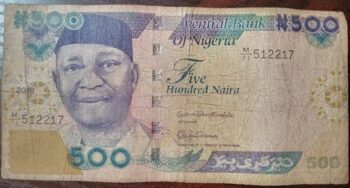
For instance, in 2008, the administration of President Musa Yar’Adua planned to redenominate the naira from 1 new naira to 100 old naira. But the plan was suspended due to monetary advice from experts.
Inflation due to poor monetary and economic policies coupled with official corruption among top government officials and lavish spending through estacodes among them has not helped the Nigerian currency against its competitors at the foreign exchange market.
For instance, the apex bank claimed it attempted to control the annual inflation rate below 10 per cent, but in 2011, it keyed the interest rate six times, rising from 6.25 per cent to 12 per cent.
In order to control the impact of inflation as a result of a reduction in fuel subsidies, the apex bank maintained the key interest rate at 12 per cent.
And on June 20, 2016, the naira was allowed to float, after being pegged at 197 to one US dollar at the official CBN exchange rate.
Although, the official CBN of USD to naira has been described as manipulative several times by some monetary experts and economists, saying it was not a thorough reflection of the power of the naira in the exchange market against its competitors.
Usually, the gap between the official rate and the parallel market price (blackmarket rate) is higher than it should be.
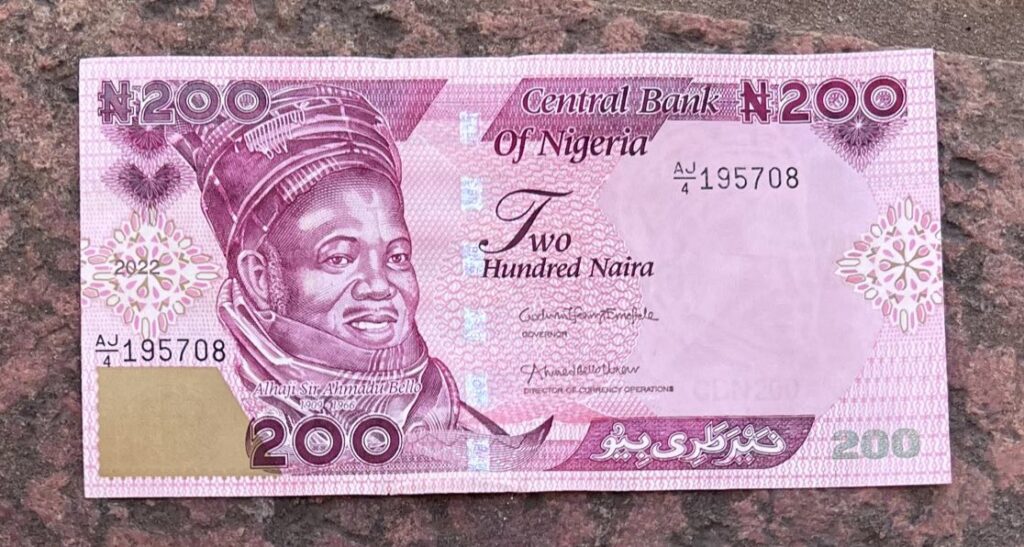
Coins
The denominations of the Nigerian currency on the inception of Nigeria’s monetary independence were in coins which included 1⁄2, 1, 5, 10 and 25 kobo, with the 1⁄2 and 1 kobo in bronze and the higher denominations in cupro-nickel.
The 1⁄2 kobo coins were minted only in 1973 till they faded off the economy
In 1991, smaller 1, 10 and 25 kobo coins were issued in copper-plated-steel while 50 kobo and 1 naira were nickel-plated-steel.
On February 28, 2007, new coins were issued in denominations of 50 kobo, 1 and 2 naira, with the 1 and 2 naira bimetallic. The ₦2 coin raised a lot of questions bothering on usability
An announcement by the central bank, 1⁄2 to 25 kobo coins were withdrawn from circulation with effect from February 28, 2007.
The apex bank gave May 31, 2007, as a deadline for Nigerians to exchange the old currency for new ones
Changes and new introduction of naira
In April 1984, during the military regime of Maj.Gen. Muhammadu Buhari, the colours of all naira banknotes were changed in an attempt to control money laundering as part of its government’s anti-corruption crusade.
In 1991, during the regime of Gen Ibrahim Badamosi Babangida, 50 naira notes were issued, while the 50 kobo and 1 naira notes were replaced by coins the same year.
In 1999, 100 naira was introduced into the economy and the following year (2000), the administration of Olusegun Obasanjo launched 200 naira.
Before the expiration of Obasanjo’s two-term in office, more currencies were introduced. For instance, 500 naira came into being in 2001 and by October 12, 2005, the highest currency 1000 naira (NGN1,000) was introduced.
Obasanjo’s administration which appointed Prof. Charles Soludo as the CBN governor did not only introduce a new set of currency, his regime also witnessed the most radical versions of the naira.
On February 28, 2007, new versions of the 5 to 50 naira banknotes were introduced. There were plans to make the 10, 20 and 50 naira polymer banknotes, but the 5,10 and 50 were delayed to late 2009 and only the 20 was released in a polymer.
When there was a change of baton, Sanusi Lamido Sanusi (who took over from Soludo as CBN governor), changed the 5, 10 and 50 naira to polymer notes in mid-2009.
The 1000 naira notes also got new features: a subtle shiny strip running down the back of the note. It is a shimmery gold colour showing 1000 naira.
The 1000 naira has on it engraved portraits of two former governours of the CBN: Alhaji Aliyu Mai-Bornu and Dr Clement Isong.
Factual error on naira
When the 100 naira notes were first issued in 1999, Zuma Rock was captioned as being located in the Federal Capital Territory, Abuja, instead of Niger state.
Later prints corrected the factual error and removed the reference to FCT, ABUJA. Although, the larger part of the FCT was carved out of Niger State.
The Aborted 5,000 Naira Note Project
On August 23, 2012, the governor of the Central Bank of Nigeria at the time Sanusi Lamido Sanusi disclosed that Nigeria would introduce 5,000 Naira notes.
He announced plans to convert NGN5, NGN10, and NGN20 into coins while other denominations like NGN50, NGN100, NGN200, NGN500 and NGN1000 would be redesigned with added new security features.
There were criticisms from across Nigeria, including the lawmakers at the National Assembly, Abuja, saying if the new NGN5,000 notes were introduced it would not only render other lower denominations valueless, but the idea would trigger high inflation and bring more hardship upon Nigerians.
Alhaji Sanusi, a former Group Managing Director of First Bank Plc, sold the idea of the new NGN5k notes to the administration of Goodluck Jonathan which he accepted.
On September 4, 2012, the idea received the endorsement of the Economic Management Team which was chaired by Jonathan.
The team stated that there was no link between inflation and currency denomination. The aim of the new 5,000 naira notes was to shore up the value of naira, the team submitted.
While the idea looks brilliant to the brains behind the proposed NGN5,000 banknote, Nigerians kicked against it and the government of Jonathan bowed to public pressure.
On September 20, 2012, the president instructed the Sanusi-led CBN at the time to put the idea of the new naira notes on hold.
Although, the CBN had received the blessing of Jonathan on December 19, 2011, when the “Project Cure” on currency restructuring was kick-started by Nigeria’s apex bank.
Criticisms against polymer banknotes
The polymer notes were lighter, water-resistant and looked more beautiful than the old notes, but poor handling among Nigerian users called its usability to question.
And the CBN reacted, saying it would no longer issue banknotes on polymer citing environmental issues and high cost or production.
Innovations in naira
On November 12, 2014, the Lamido-led CBN with the directive from the presidency issued a 100 naira commemorative note to celebrate the centennial of Nigeria’s existence.
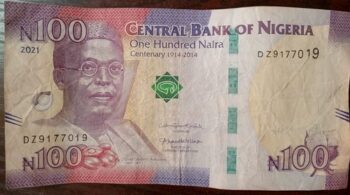
The notes are similar to the existing issue with the portrait of Chief Obafemi Awolowo on the front, but included a new colour scheme, revised security features, and the text “One Nigeria, Great Promise” in microprinting makes it more unique.
Not only that, it also added a quick response code (QRC) which when scanned leads holders to a website about Nigeria’s history.
The most interesting moment in the history of Nigerian currency was when Priscilla Ekwere Eleje was appointed as the first the Director of Currency Operations of the CBN, thereby becoming the first female to have her signature on the naira.
Redenomination of the naira
In August 2008 there was a plan to make the 100 naira become 1 naira, one of the moves by President Umaru Musa Yar’Adua-led administration to redenominate the naira. The plan was later shelved by the administration.
Exchange Rate naira against USD
Nigeria witnessed an oil boom and sales in 2007 which boosted the value of naira against the US dollar.
The same year, Professor Chukwuma Soludo (CBN governor) disclosed that the weekly central bank auctions of foreign currency will gradually be phased out.
He said that the bank would “only intervene in the market as may be required to achieve defined policy objectives”.
Coins and naira denomination
Nigerian currency were issued in denominations of:
- 1 kobo (₦0.01)
- 2 kobo (₦0.02)
- 5 kobo (₦0.05)
- 10 kobo (₦0.10)
- 20 kobo (₦0.20)
- 50 kobo (₦0.50)
- 1 naira (₦1)
- 5 naira (₦5):
- 10 naira (₦10)
- 20 naira (₦20)
- 50 naira (₦50)
- 100 naira (₦100)
- 200 naira (₦200)
- 500 naira (₦500)
- 1000 naira (₦1000)
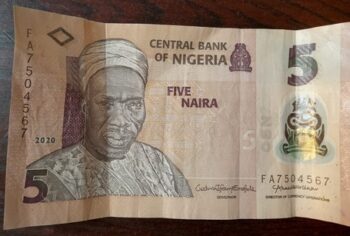
Due to high inflation, all the coins (1 kobo, 2 kobo, 5 kobo, 10 kobo, and 20 kobo) are no longer in use, though there was another plan to reintroduce coins into Nigeria’s economy by the country’s House of Representatives as one of the moves to curb inflation.
Apart from the coins, 5 naira and 10 naira banknotes are now worthless because of their lesser value.
CBN Digital Currency (eNaira)
While the apex bank was battling with how to control the pressure on the fiat currency Naira notes, it introduced a Central Bank Digital Currency dubbed eNaira.
The CBN governor Godwin Emefiele disclosed that the eNaira would be denominated in naira. This means that eNaira has the same value as the fiat currency.
Originally scheduled for launch on October 1, 2021, to commemorate Nigeria’s Independence Anniversary, it was postponed to October 25, 2021 due to some criticisms the CBN had to correct.
For instance, the bank used .com TLD while there is the availability of .ng or gov.ng for its official portal.
And on October 25, the eNaira was launched by President Muhammadu Buhari, with the slogan “Same Naira, More Possibilities” amid the usual funfair in Abuja, Nigeria’s administrative capital.
Though Nigeria’s digital currency holds a lot of possibilities like creating jobs for agents among other benefits of eNaira, the majority of Nigerian youths who are more technologically driven bombarded the eNaira App on Google Play Store with bad reviews, it was pulled down by the developers.
It was restored on October 28, 2021, after fixing some issues that were raised. But the app continues to get low patronage among Nigerians.
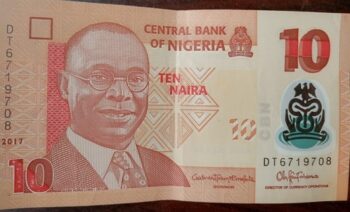
There are two types of eNaira app: 1) individual eNaira Speed Wallet, 2) Business eNaira Speed Merchant Wallet.
At the time of publication (Wednesday, March 30, 2022), the individual speed wallet had 100K downloads while the merchant version had 50k+ downloads with terrible reviews.
Some users of the eNaira Speed Merchant Wallet say support was poor and terrible. Up till now, the eNaira has not enjoyed the much-needed acceptability by the general public.
The eNaira has not in any way been seen as an alternative to the naira
When were the Nigerian banknotes introduced?
Below is a list of Nigerian banknotes, when Nigerians started using them and the president who introduced them into the economy
| Nigerian Banknotes | Year of Introduction | Who Introduced Them? | CBN Governor in Office During Launch |
| 1 naira | July 2, 1979 | Gen Olusegun Obasanjo | Dr. Ola Vincent |
| 5 naira | July 2, 1979 | Gen Olusegun Obasanjo | Dr. Ola Vincent |
| 10 naira | July 2, 1979 | Gen Olusegun Obasanjo | Dr. Ola Vincent |
| 20 naira | February 11, 1977 | Gen Olusegun Obasanjo | Mallam Adamu Ciroma |
| 50 naira | October 1991 | Gen. Ibrahim Babangida | Alh. Abdulkadir Ahmed |
| 100 naira | December 1999 | President Olusegun Obasanjo | Dr Joseph Sanusi |
| 200 naira | November 1, 2000 | President Olusegun Obasanjo | Dr Joseph Sanusi |
| 500 naira | April 4, 2001 | President Olusegun Obasanjo | Dr Joseph Sanusi |
| 1000 naira | October 12, 2005 | President Olusegun Obasanjo | Prof Charles Soludo |
Who are the prominent Nigerians on Nigerian banknotes?
| Banknotes | Faces on Nigerian Currency | Notes |
| NGN1 | Herbert Samuel Macaulay | He’s the founder of Nigerian nationalism |
| NGN5 | Alha Abubakar Tafawa Balewa | Former Nigeria’s Prime Minister |
| NGN10 | Alvan Azinna Ikoku | He proposed 6-year for primary school education |
| NGN20 | Gen. Murtala Ramat Muhammed | Former military Head of State |
| NGN50 | 4 Nigerians, 3 men and a woman | The backside depicts fish farming typifying the popular Argungu Fish farming |
| NGN100 | Chief Obafemi Awolowo | First Premier of Western Region |
| NGN200 | Alh. Ahmadu Bello | Former Premier of Northern Region |
| NGN500 | Dr Nnamdi Azikiwe | Nationalist and former Nigeria Vice President |
| NGN1000 | Alh Ali Mo-Bornu Dr Clement Nyong Isong | First Nigerian governor of CBN Second Governor of CBN |
What year was naira higher than dollar?
The Nigerian currency started losing its value beginning from 1986, $1 jumped to N2.02 before the end of 1986
Who introduced one thousand naira note in Nigeria?
Who is inside 200 naira?
Who introduced most of the Nigerian banknotes?
How many Nigerian currency did Obasanjo introduce?
Official Exchange Rates of Dollar to Naira
Between 1973 the CBN official exchange rate was NGN0.658 to a dollar, 10 years after, $1 was exchanged for NGN0.724.
In 1993, the naira depreciated against the USD as $1 was worth NGN17.30 and by 2003, the dollar has gained more against the naira, trading between NGN114 to NGN127 against $1.
And by 2013, it was NGN162/$1. At the time of publication, the official exchange rate in Nigeria stood at NGN416 against the USD. You can check the history of official exchange rate in Nigeria on one of our articles
While some banks sell dollars at NGN505, the black market (parallel market) ranges from NGN570 to NGN580, thereby creating a wide gap that an economist once described as CBN manipulative stand to cover up irregularities.
Unlike the 1970s, when the naira was among the strongest currencies in Africa, the Nigerian currency is today among the weakest on the continent.
Floating of Naira
On June 14, 2023, Nigeria’s apex bank announced the floating of the Naira, thereby allowing the market forces to determine the price unlike before when the Emefiele-led team dictated the price. It also means that the direct intervention of the CBN from the forex market has gone.
The N471 was previously quoted by the CBN and the I&E window has now been adjusted to trade between N664 and N775. At the time of this update, the rate was NGN589.45

